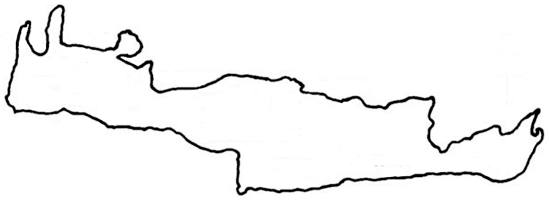
|
The Society of Folk Dance Historians (SFDH)
A Cretan Affair
[
Home |
About |
Encyclopedia | CLICK AN IMAGE TO ENLARGE |

|
 Greek dancing is a lot of fun when you are compelled to join in and not just watch from the sidelines. It is then that you discover how truly thrilling it can be – whether you're leading or dancing with others on either side of you in a circle. If you're lost, you will soon be guided which way to go. It's best not to look at the feet – it will only confuse you when trying to figure out if your own feet should cross in front or back. Anyway, such details are irrelevant at first. After all, you are not performing you are participating. It's like jumping into a pool; like it or not you paddle to stay afloat. Once you catch on to the simple nuances and start to sense the rhythm then you're home safe. Greek festivals and gala affairs offer a welcome opportunity to tap your feet and catch the Greek-dance fever.
Greek dancing is a lot of fun when you are compelled to join in and not just watch from the sidelines. It is then that you discover how truly thrilling it can be – whether you're leading or dancing with others on either side of you in a circle. If you're lost, you will soon be guided which way to go. It's best not to look at the feet – it will only confuse you when trying to figure out if your own feet should cross in front or back. Anyway, such details are irrelevant at first. After all, you are not performing you are participating. It's like jumping into a pool; like it or not you paddle to stay afloat. Once you catch on to the simple nuances and start to sense the rhythm then you're home safe. Greek festivals and gala affairs offer a welcome opportunity to tap your feet and catch the Greek-dance fever.
I was captivated by a sequence of events at a Cretan glendi (party). When a vivacious musician visiting from Crete began strumming his lyra (a pear-shaped, three-stringed bowed musical instrument) with a doxari (the bow), magical sounds flew into the air drawing people out of their chairs and onto the dance floor where they moved to the syncopated rhythm of a Haniotiko Syrto. Right away the mood warmed up. Dancers tested their abilities with embellished twists and turns, instantaneous halts and dramatic pauses, followed by sudden spins. Many young dancers eagerly waited for their turn to lead the line. Older dancers also vied for their select moment; they hadn't yet abandoned their terpsichorean feats and often outmatched their younger counterparts. An impromptu choreographic tour-de-force contest ensued as dancers – with postured humility – gallantly turned over the lead so others could equally join the exhibition. Women were not about to step aside and be overshadowed; they too found a way to express courtly feminine movements and delicately charmed everyone by executing brisk intricate steps.
Throughout the evening, music and dancing continued nonstop like an evocative ritual. The high-pitched music led the dancers through the gamut of exciting Cretan dances. With equal vigor, young men, some adorned with traditional kerchiefs resembling black teardrops on their foreheads, quickly snapped into a hectic sequence of movements, interpreting every agitated beat made by the lyra player. Dancer verses musician, each trying to outwit the other.
Cretan dances depict great subtlety of movement. An inner agitation is revealed in a variety of fancy maneuvers. Young women break away from the circle in twos or threes, spinning like whirling windmills to the throbbing rhythm. Through a maze of unending circles, modest aspirations take place. Glances are exchanged, eyes meet, and dancers explore the possibility of finding a way to edge over in line to be next to someone of interest. It is no secret that many a mate has been discovered on the dance floor; matchmaking is always in the air. Young people tend to silently stake one another out as dancing brings people together subliminally. Exploration continues through the various dance styles, which reveal personalities and give a quick lesson in pre-courting consideration. The Haniotiko Syrto is quite social so casual chitchat is accepted during the repetitive dance sequence in the circle. People drift in and out of the line dance, hardly excusing themselves, and may return a moment later to a more "desirable" position in the circle. It's different from the Pentozali, which imposes a more restrictive attitude for dancers participating in its quick-paced tempo. This dance however provides a perfect excuse for the lead dancers to execute brilliant combinations of steps that knowingly or not have often captured a wistful heart.
One tumultuous dance in the Cretan tradition that breaks all the rules and has become a favorite among many young people is the Maleviziotikos. This dance definitely demonstrates an ancient legacy and at a Cretan glendi. It is common for the music to play well beyond the "three minute set" norm. Often, the dancing easily lasts beyond a fifteen-minute sequence up to as long as half an hour, with multiple changes of leaders all exhibiting the gamut of athletic leaps reminding one of the ancient mural scenes of Knossos depicting youths leaping in the air over bulls' horns. It is a joy to watch young second and third generation Greek Americans respond to this folklore and dance with passion and conviction as if they had been raised in Crete. The whirling circle dance with its mysterious flow continues to inspire followers despite our predominately American pop culture; these ancient Cretan traditions still speak to new generations.
DOCUMENTS
- Athan Karras, an article.
- Cretan Passion for Dance, a country.
- Crete, a region.
- Greece, a country.
Used with permission of the author.
This page © 2018 by Ron Houston.
Please do not copy any part of this page without including this copyright notice.
Please do not copy small portions out of context.
Please do not copy large portions without permission from Ron Houston.